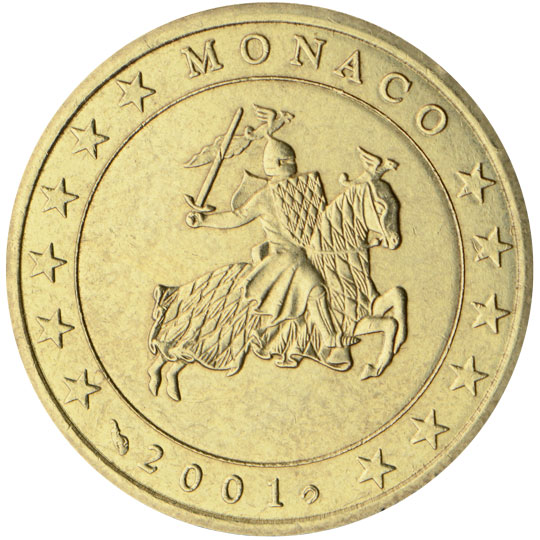For the participating states, Euro coins are a great way of transporting their self-image to the outside world – to their citizens, handling small change on a daily basis, and to their visitors, taking the change back home after a holiday. Today we’re looking at Monaco and how it presents itself on its coins.

Monaco is a principality in which Albert II, reigning since 2005, possesses a wealth of power that seems to belong to another century. And yet: When the euro was introduced under Albert’s father Rainier III (1923-2005), the ruler didn’t dominate the coin’s iconography as it did, for instance, in the Netherlands or in Belgium, where the monarch possesses significantly fewer political rights. The only coin that showed Rainier alone was the 2-euro coin. The 1-euro coin he shared with his heir to the throne, Albert, who is featured on both coins since his father’s death, all by himself. With all of the images that were originally to be seen on the cent coins, the House of Monaco reaches back into its past, to a romantic time long ago: the Medieval Ages, when everything was still possible if you were an unscrupulous and capable man; when new dominions were founded, most of whom disappeared again, but some of whom – like that of the Grimaldis – have survived until this day.
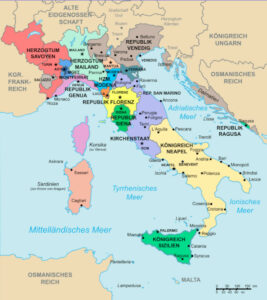
Beginnings in Genoa
The House of Grimaldi originally hailed from Italy. To be more precise, it was one of the Italian houses which had considerable say in the politics of the city of Genoa. The first ancestor whom we know by name was Ottone Canella, who ruled Genoa in 1133 and 1135 as a consul. One of his sons, Grimaldo, gave the house its name. But it isn’t until one of the great-great-grandsons of Grimaldo that the connection with Monaco becomes of interest to us.
Rainier I lived from 1267 to 1314. In those years Genoa was at the height of its power. A treaty with the Byzantine emperor had granted the Genoese the trade monopoly in the Black Sea and secured their control over the ship passages to India and China, of course much to the dismay of the cities Venice and Pisa, which constantly tried to challenge Genoa’s hegemony at sea. At the time, Corsica also belonged to Genoa – as did Monaco, a seaport strategically well located at the seaways in the Western Mediterranean. In 1215 the Genoese had invaded the small place nested upon the rocks and secured it by means of a massive fort. In 1250 they built a new castle at the harbor entrance. Like many medieval fortresses, Monaco was almost impenetrable. Almost, that is…
Because Genoa was ruled by the Ghibellines at the time and they were a thorn in the flesh of the Guelphs, to which Grimaldi belonged. Even though these townspeople were hiding behind slogans like Welf (Guelphs; opposition of the emperor) and Waibling (Ghibellines; supporters of the Staufian emperors), the real motivation behind their quarrels were mostly power-political struggles for the supremacy of one city or another. Time and again, the Grimaldis in Genoa tried to kick representatives of the rivaling families, members of the Spinola and Dora families, out of their offices, occasionally by force of arms. Sometime around 1296 it came to a forty-day street battle, it is said, in the course of which the Guelphs were defeated and the Grimaldis driven out of Genoa. So they had to find and conquer a new home.
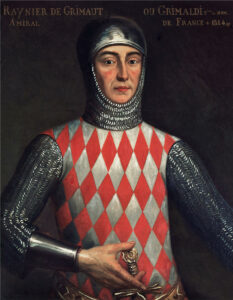
A Trojan Monk
This happened, if we are to believe Monaco’s founding myth, on January 8, 1297. The winter day is said to have been icy cold. The wind blew big waves into the normally so quiet harbor of Monaco, and no ship was able to moor. In the dead of night – so the story goes – a Franciscan monk, looking chilled to the bone, clad only in his brown woolen cowl, requested admission at the fort’s gate. The guards felt sorry for this harmless-looking Christian beggar. They opened the gate for him. Three guards, two of them already hopelessly drunk. And so Francesco Grimaldi, called “Malizia” (malice), had an easy job of killing the three soldiers with his sword, which he’d hidden under his voluminous cowl until now. The poor monk had been a warrior in disguise, following the best advice which medieval war manuals offered for conquering forts: Don’t even attempt a siege, but take the fort by stratagem. Now he opened the gates and let the allies waiting outside in. It didn’t take long until the city, then fast asleep, was taken and Rainier I, “Malizia’s” older brother, could seize power and rule over Monaco.

It is to this “chivalrous” time that the Monacan euro coins allude. The 1, 2, and 5-cent coins show the Principality’s coat of arms. It is flanked by two sword-wielding monks. Thus Monaco, together with Finland, Ireland, and Lithuania, is among the few European minting authorities that still represent their country with reference to medieval coats of arms on the euro coins.
“Corporate Identity” in the Middle Ages
Coats of arms came into being in the end of the 12th century due to a very particular need on part of the knights. Every single of these proud fighters lived off his glory. To win glory, men rushed into battle, took risks at deadly tournaments which matched those at war. But by the end of the 12th century they had run into an existential problem. During the course of this century, the armor had changed in a way that rendered the individual knight unrecognizable. A long chain mail veiled his body from top to toe, and a helmet covered his face. No one could identify the valiant knight in a battle or at tournament – which took the shape of a general turmoil more often than that of a duel. And from the knight’s perspective that was a shame because how should the ladies and troubadours praise his deeds when they couldn’t even see that he’d just performed them? That’s why escutcheons, which had served predominantly decorative purposes until then, became proper marks of recognition to identify the fighter.
While at first “coats of arms” were merely used as individual marks of recognition, they were soon used not to refer to individuals any longer but to the entire family at once. Later they would come to symbolize a dominion – country, city, or bishopric – and thus become transferable. In the Renaissance and Baroque era the personal coat of arms was a combination of all dominions over which the respective prince ruled.
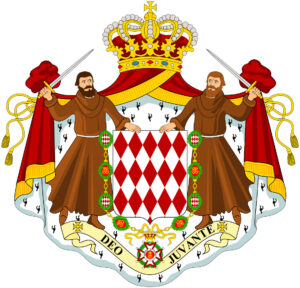
“Speaking” coats of arms developed pretty quickly, i.e. coats of arms which translate the name of a dominion into an image. Just to name a few examples, the luce (fish) was shown on the seal of Richard de Lucy in the 12th century already. The coat of arms of the Zurich family of Affenstein (literally: monkey rock) featured a red monkey breaking a rock. That perhaps Monaco features its monks on its coat of arms solely because of its name (Latin: monachus = monk) would be a prosaic explanation for the sword-wielding monks on the coat of arms. However, it would not be the first time that successive generations who have no explanation for the image anymore make up fun little stories about it.
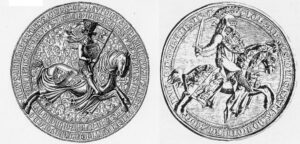
Riding the High Horse
Be that as it may, the Grimaldis only ruled Monaco for four years after their surprising coup. After that, they had to give up the little harbor fort for a compensation of 6,000 pounds. For Rainier I that was by no means a fatal blow. He was working as a condottiero at the time, an entrepreneur in warfare. He hired a small troop at his own expense, equipped it, and then rent it out to the highest bidder. Rainier made a lucky choice in his employer. While other condottieri went bankrupt because their clients wouldn’t pay them, Rainier worked for one of Europe’s richest kings, Philip the Fair, King of France. Philip paid for his services regularly, even gave him an annual stipend of 1,000 pounds, and enfeoffed several estates, far off from one another, to his admiral Rainer – an income that secured him an affluent lifestyle.
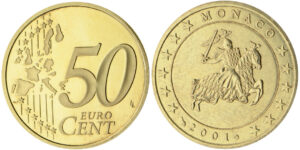
So Rainier I Grimaldi had moved up through the ranks of society to the ruling class. And he had done so thanks to his own, chivalric achievements. A fact which his descendant Rainier III of Monaco proudly commemorated with his first euro coin series. The reverse of the 10-, 20-, and 50-cent coins up until 2006 is dedicated to the pride of each chivalric house, the big seal depicting a knight on horseback riding to the right. Such seals were widespread in the Middle Ages. And they look so similar that it is hard for the contemporary beholder to tell them apart.
Seeing how much we revere personality in this day and age, it may strike us as odd that none of these rulers show their face. It is hidden behind the visor. But individuality as something that is expressed in someone’s facial features was not the point of art back then. The commissioner rather wanted to be recognized in his official capacity, for his rank. He felt like a link in a chain of people, ancestors, and descendants all carrying the same coat of arms as he did, and who once brought, were bringing, or would bring him honor.
So the Prince of Monaco aligned himself with the heritage of his medieval predecessors, who in 1330 had been given Monaco as a fiefdom by request of the French king. However, whether Genoa or France was the real overlord would be a point of contention for centuries to come. In the 19th century, Italy and France were still jostling for the possession of the now rich Monaco.

Glamour and Gossip
Because even though its rulers like to see themselves in the tradition of the Middle Ages, the country really owes its wealth to the rich and famous who brought the casino and tax exemption to the rock in the middle of the sea. Prince Rainier and his children were always the best advertising for their country you could get. For a long time, not a week went by in which the yellow press didn’t print spectacular articles or the rulers of Monaco sued them for compensation for doing just that. And even when trying to excuse the amorous escapades of his offspring, Rainier liked to go back to the Middle Ages for inspiration. Once upon a time – according to legend – Rainier I is said to have abducted and raped a fair young Fleming on a military campaign. The lady, however, was a witch and cursed him and his descendants for eternity. No Grimaldi, she is said to have foretold, would ever be happy in a marriage again. Bless her, because, let’s face it, what would our gossip columnists write about if the Grimaldis were to turn faithful and staid all of a sudden?
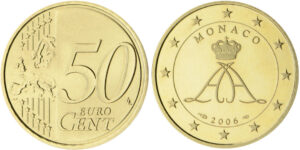
Albert II has been the reigning Prince since 2005. He has been trying to rid himself of his reputation as a first-class Lothario, which he previously fought long and hard to obtain. Maybe that explains why the chivalric seal has disappeared from the 10-, 20-, and 50-cent coins. The new motif: two intertwined and crowned As, Albert’s personal standard. Not terribly exciting, but dignified and appropriate. And, to come full circle (remember the opening of the article): It’s also a step away from the tradition of pointing to one’s ancestors and towards a greater presence of the prince himself on the coins.



